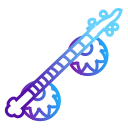Domain:Performing arts
State: Uttar Pradesh
Description:
Agra is known as the city of architectural grandeur. Hindustani Classical Music flourished under the patronage of King Akbar. The word Gharana is believed to be a combination of a Hindi word, Ghar (house) and a Persian word ana (of the). Therefore, the concept of Gharana implies an exclusive style of singing where basic notations of the Ragas remain the same, which are sung according to the particular style followed by a Gharana. Agra Gharana is a blend of Khayal Gayaki and Dhrupad-Dhamar. Ustad Ghagge Khuda Baksh is considered to be an important person in the field of Khayal Gayaki, who transformed the old style to derive his own style of Khayal Gayaki. Gwalior Gharana is considered to be the parent of Khayal tradition, although they are believed to have imported Khayal from Lucknow. It was during the reign of Nawab Asaf-ud-Daulah that his court musician, Ghulam Rasood invented the Khayal gayaki. Interestingly, his son, Ghulam Navi is known to be the master of Tappa Gayaki. (He is also known as Shore miyan) He went to Punjab to study the ethnic music of Punjab and gave it a new form. This was exported to Gwalior by Shore Miyan which consequently explains the closeness of Gwalior Gayaki with Tappa.
Agra Gharana was originally connected with the dhrupad tradition, where Khayal Gayaki was introduced later. It is associated with Nauhar Bani which is known to have existed from the period of Allauddin Khilji. The first recorded music of Agra Gharana was by its famous member Zohrabai Agrewali. She was a disciple of Ustad Sher Khan, Ustad Kallan Khan and Ustad Mehboob Khan. It is said that Zoharabai’s gayaki was close to the Gwalior tradition as well. She was also known for her singing of Thumri and Ghazal which she learned from Ahmad Khan of Dhaka.
Agra and Jaipur Gharana were particular about Raag Roop. One of the notable personalities of Agra Gharana was Ustad Faiyaz Khan. He felt the need of alap and vistar in Khyal Gayaki and he combined dhrupad with khayal singing, which was one of his specialties. He was the court musician of Sir Sayajirao Gaekwad III, the Maharaja of Baroda.
 Government of India
Government of India
































 Recognizing the ongoing need to position itself for the digital future, Indian Culture is an initiative by the Ministry of Culture. A platform that hosts data of cultural relevance from various repositories and institutions all over India.
Recognizing the ongoing need to position itself for the digital future, Indian Culture is an initiative by the Ministry of Culture. A platform that hosts data of cultural relevance from various repositories and institutions all over India.

